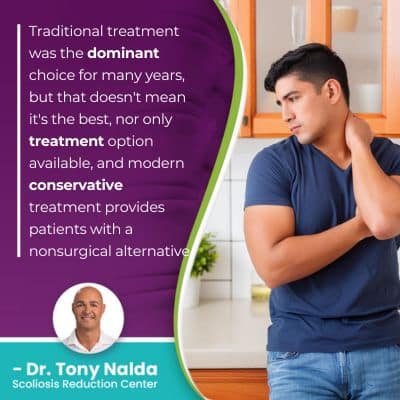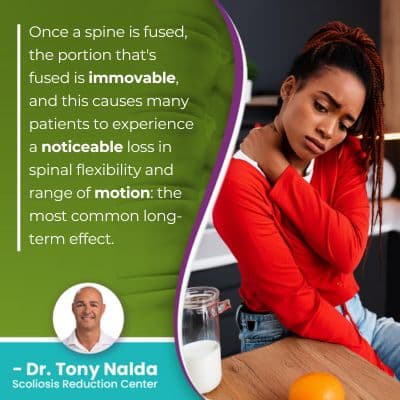How Dangerous Is Scoliosis Surgery: Risks vs. Benefits

There are risks involved with any surgical procedure, but spinal surgery can be particularly costly, invasive, and risky, not to mention how it can affect the spine. Scoliosis surgery is a type of spinal fusion, and while there are different types of procedures, the goal is the same: to stop progression.
There are different ways to address scoliosis with treatment, and it's important to understand the difference because the choice will shape long-term spinal health and function. While scoliosis surgery, when successful, can straighten a bent spine, it can also make the spine weaker and less flexible.
As a progressive condition, scoliosis has it in its nature to get worse over time, so let's explore the nature of scoliosis progression.
Table of Contents
Scoliosis is a Progressive Condition
Scoliosis is a structural spinal condition that can cause a wide range of symptoms; it involves the development of an unnatural sideways spinal curvature that bends and twists.
Progressive conditions have it in their nature to get worse over time, and when it comes to scoliosis, this means the size of the unnatural spinal curve is going to increase over time, as are the condition's uneven forces, and their effects.
We don't always know what triggers scoliosis to develop, but we do know what makes it get worse: growth.
So adults with scoliosis will still progress, but it's children who are the most at risk for rapid progression, and in particular, adolescent idiopathic scoliosis because of the rapid and unpredictable growth spurts of puberty.
Scoliosis introduces a lot of uneven forces to the body, and as those uneven forces increase, the condition's symptoms become more noticeable; in children, the main signs of scoliosis involve postural changes and disruptions to balance and gait, and in adults, the main condition effect to get worse alongside progression is pain.
Scoliosis doesn't become a compressive condition until skeletal maturity has been reached, which is why it's not commonly painful for children; although muscle pain can be an issue, back pain and pain that radiates into the extremities is associated with compressive adult scoliosis.
When it comes to being diagnosed with scoliosis, regardless of age or severity, the most important decision to be made is how to treat it moving forward.
Scoliosis Treatment Options: Surgical vs Nonsurgical
 There are two main scoliosis treatment approaches for patients to choose between: traditional and conservative treatment.
There are two main scoliosis treatment approaches for patients to choose between: traditional and conservative treatment.
Traditional treatment was the dominant choice for many years, but that doesn't mean it's the best, nor only treatment option available, and modern conservative treatment provides patients with a nonsurgical alternative.
So what are the benefits and risks associated with each? What I want most for all patients is to fully understand the pros and cons of all treatment options available to them so they can make informed choices.
So how dangerous is scoliosis surgery? Let's start there...
The Benefits and Risks of Spinal Fusion Surgery
While there are different types of spinal fusion surgery, some considered minimally invasive scoliosis surgery, some involve posterior spinal fusion, others use anterior scoliosis correction.
While there are different methods and approaches for accessing the spine, the concept is the same, and in typical spinal fusion, the curve's most-tilted vertebrae at its apex are going to be fused together into one solid bone, and this is done so they can't become more unnaturally-tilted over time.
This commonly involves the removal of intervertebral discs that sit between adjacent vertebrae to be fused, and also commonly involves attaching rods to the spine with pedicle screws to hold it in place; the removal of these discs is contrary to the spine's movement-based design, as is fusing it to make it immovable in one portion.
Curve progression can be stopped because the spine is artificially held in place, but this isn't the same as correcting the scoliosis on a structural level, which we'll return to.
Spinal fusion surgery, when successful, can straighten a scoliotic spine, but there are risks associated with the procedure itself, along with the potential long-term side effects of living with a fused spine.
Some risks associated with the procedure itself can include:
- Infection
- Nerve damage
- Excessive blood loss
- Adverse reaction to hardware used
No two patients will respond to spinal fusion in the exact same way; there are a number of factors that shape how a patient responds: age and overall health, condition type, severity, the number of vertebrae fused, and the location of the fused portion.
What concerns me most about spinal fusion is the permanency of its result; a fused spine is fused for life, and if it's unsuccessful, the only recourse is more surgery, and the risks only increase with age and each subsequent procedure.
The risks I really want patients to understand, however, are the long-term effects because these are what shapes a person's long-term spinal health.
Long-Term Effects of Spinal Fusion Surgery
So, again, the benefit of spinal fusion surgery is that it can stop the condition from becoming worse over time because the spine can't bend and twist, and in some particularly severe forms and/or atypical types of scoliosis, surgical intervention is necessary, but the reality is that many cases of scoliosis don't require surgery.
Once a spine is fused, the portion that's fused is immovable, and this causes many patients to experience a noticeable loss in spinal flexibility and range of motion: the most common long-term effect.
While some patients maintain enough flexibility above and below the spine's fused portion, for those that don't, activity restrictions can become an issue that impacts overall quality of life.
In addition, a spine that's fused is going to be excessively rigid, and this can cause increased pain at the fusion site and can also make it difficult to participate in once-loved activities, and a fused spine is weaker and more vulnerable to injury.
Now that we've covered the risks of spinal fusion surgery, let's talk about the benefits of conservative nonsurgical treatment.
The Benefits of Nonsurgical Treatment
 Here at the Scoliosis Reduction Center, my patients benefit from a proactive nonsurgical conservative treatment approach that works to preserve the spine's natural strength, function, and movement-based design.
Here at the Scoliosis Reduction Center, my patients benefit from a proactive nonsurgical conservative treatment approach that works to preserve the spine's natural strength, function, and movement-based design.
The benefit of conservative treatment is that it's proactive; it's started as close to the time of diagnosis as possible because this is when conditions are at their mildest so they are likely to be at their most responsive to treatment.
Conservative treatment combines multiple scoliosis-specific treatment disciplines so conditions can be impacted on every level for true corrective results; I don't just want to hold the spine in a corrective position, I want to correct it on a structural level, and this involves condition-specific chiropractic care.
A series of chiropractic techniques and adjustments can work towards realigning the spine by manually adjusting the curve's most-tilted vertebrae and realigning the spine.
Once I see structural results in the form of a curvature reduction, I can shift the focus to increasing core strength through the application of scoliosis-specific physical therapy and scoliosis-specific exercises.
Increasing the strength of the spine's surrounding muscles means the spine is optimally supported and stabilized.
Corrective bracing is particularly effective on growing spines so is a regular facet of treatment for childhood scoliosis, and this can augment corrective treatment results by pushing the spine into a correct position.
The final phase of treatment is ongoing, and this is necessary for long-term sustainable treatment results because as a progressive condition, scoliosis treatment is about managing a lifelong condition.
Conclusion
How dangerous scoliosis surgery is will depend on the patient; there are many factors that shape how a person responds to treatment, but spinal fusion is invasive and carries some serious potential risks, side effects, and complications, so should be considered carefully.
While scoliosis surgery does have the benefit of straightening a bent spine, it's not always necessary, and can cost the spine in other ways.
Conservative treatment isn't permanent; if it's unsuccessful, the spine isn't permanently altered, and the proven results of a chiropractic-centered approach shows that not all cases of scoliosis need surgery.
The benefit to conservative treatment is that it's proactive so works towards preventing progression, while surgical treatment is more about responding to conditions once a certain severity level has been reached, but does little beforehand to prevent progression.
In many cases, it's more effective to proactively work towards preventing progression and increasing condition effects than it is to reverse them once established.
Scoliosis surgery is associated with some major risks that conservative treatment doesn't pose, and if scoliosis is left untreated, complications such as breathing difficulties can develop.
Surgical correction can come at a price, and I want patients to fully understand how that can affect overall quality of life so the best treatment choice can be made.
Dr. Tony Nalda
DOCTOR OF CHIROPRACTIC
After receiving an undergraduate degree in psychology and his Doctorate of Chiropractic from Life University, Dr. Nalda settled in Celebration, Florida and proceeded to build one of Central Florida’s most successful chiropractic clinics.
His experience with patients suffering from scoliosis, and the confusion and frustration they faced, led him to seek a specialty in scoliosis care. In 2006 he completed his Intensive Care Certification from CLEAR Institute, a leading scoliosis educational and certification center.
About Dr. Tony Nalda
 Ready to explore scoliosis treatment? Contact Us Now
Ready to explore scoliosis treatment? Contact Us Now





